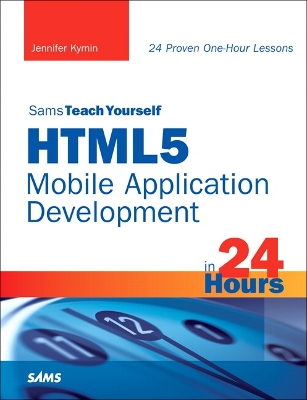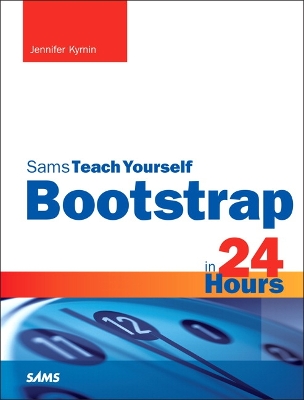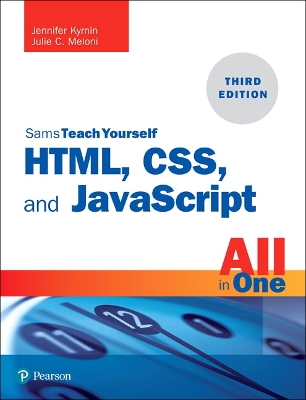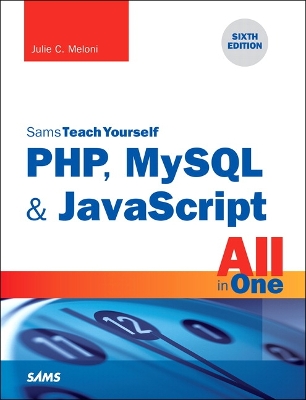Sams Teach Yourself
6 total works
Sams Teach Yourself HTML5 Mobile Application Development in 24 Hours
by Jennifer Kyrnin
In just 24 sessions of one hour or less, learn how to build rich, robust mobile apps that run on smartphones, tablets, and other devices and interact with users in powerful new ways. Using this book’s straightforward, step-by-step approach, you’ll master leading-edge practical skills you can use whether you’re developing for the iPad/iPhone or Android. Discover how to quickly build new mobile apps and upgrade older apps, provide cutting-edge media content, leverage advanced features ranging from geolocation to the semantic web, and even simplify complex back-end development. Each lesson builds on what you’ve already learned, giving you a rock-solid foundation for real-world success!
Step-by-step instructions carefully walk you through the most common HTML5 mobile development tasks.
Quizzes and Exercises at the end of each chapter help you test your knowledge.
By the Way notes present interesting information related to the discussion.
Did you Know? tips offer advice or show you easier ways to perform tasks.
Watch Out! cautions alert you to possible problems and give you advice on how to avoid them.
Learn how to…
- Work with the new HTML5 tags most valuable for mobile development
- Get started fast with HTML5 features already supported by today’s browsers
- Detect mobile devices and HTML5 support and upgrade sites to support them
- Style and build more efficient, usable mobile pages
- Use jQuery Mobile to quickly create mobile apps
- Leverage HTML5’s breakthrough drawing and typography features
- Efficiently integrate media content into your apps
- Add meaning with HTML5 sectioning and semantic elements
- Implement drag-and-drop more easily than ever
- Build offline applications and other apps that use local storage
- Detect and work with location data via the GeoLocation API
- Use microformats and microdata to make web pages friendlier to computers
- Add powerful back-end functionality with WebSockets, Web Workers, and File APIs
- Improve user navigation with the History API
Responsive Web Design in 24 Hours, Sams Teach Yourself
by Jennifer Kyrnin
Sams Teach Yourself Responsive Web Design in 24 Hours helps you create websites that work equally well on everything from smartphones and tablets to multi-screen monitors.
This book's straightforward, step-by-step approach shows how to use HTML, CSS, and JavaScript to build the responsive sites today's users and clients want. In just a few hours, you'll be building layouts, sites, forms, and web apps that automatically adapt to virtually any device. Every lesson builds on what you've already learned, giving you a rock-solid foundation for real-world success.
Learn how to...
Create effective and reliable responsive designs with CSS3, HTML5, and JavaScript
Use progressive enhancement to consistently provide the right content while making the most of each device and browser
Establish breakpoints and write CSS media queries to respond appropriately to each user agent
Choose the right layout and wireframing approach for your site
Use web fonts to control typography and choose sizes that look good on any device
Master three ways to make tables responsive
Build responsive forms using the latest HTML5 tags and attributes
Implement responsive navigation patterns that users understand intuitively
Test for responsiveness and performance
Use Responsive Design + Server Side Components (RESS) to optimize performance
CONTENTS AT A GLANCE
PART I: INTRODUCTION TO RESPONSIVE WEB DESIGN
HOUR 1: What Is Responsive Web Design?
* History of Responsive Web Design
* Why We Need Responsive Web Design
HOUR 2: Alternatives to Responsive Web Design
* Table-Based Layouts * CSS Layouts
* Detection Scripts
HOUR 3: The Growth of Mobile
* Basic Cell Phones
* Smartphones
* Tablets
* Retina Devices
* Why Responsive Design Is Important
HOUR 4: Progressive Enhancement
* What Is Progressive Enhancement?
* How to Use Progressive Enhancement on a
* Website
* Benefits of Progressive Enhancement
HOUR 5: HTML for Responsive Web Design
* Using HTML5 * Clean Code
* Don't Forget Semantic Elements
* Validating Your HTML
HOUR 6: Basic CSS
* How to Write CSS Rules
* Embedded and External Style Sheets
* Styling Fonts and Colors
* Creating a Layout with CSS
* Understanding Cascading and Specificity
HOUR 7:Unobtrusive JavaScript
* What Is Unobtrusive JavaScript?
* How to Implement Unobtrusive JavaScript
PART II: BUILDING A RESPONSIVE WEBSITE
HOUR 8: Planning a Responsive Website
* Should You Make Your Website Responsive?
* How to Plan for a Responsive Website
HOUR 9:Mobile First
* Why Design for Mobile First?
* What Makes a Site Mobile Friendly?
* What About Mobile Only?
HOUR 10: CSS Media Queries
* What Is a Media Query?
* Media Query Expressions
HOUR 11: Breakpoints
* What Is a Breakpoint?
* How to Define Breakpoints in CSS
* Optimal Breakpoints
HOUR 12: Layout
* What Is Web Layout?
* Types of Layouts
* Columns in Layout
HOUR 13: Navigation
* Why Responsive Navigation Is Important
* What Makes Navigation Mobile Friendly?
* Basic RWD Navigation Patterns
HOUR 14: Responsive Fonts and Typography
* Using Web Fonts
* Sizing Typography
* Relative Versus Absolute Font Sizes
* New CSS3 Measurement Units
HOUR 15: Creating and Using Images in RWD
* Making Images Responsive
* Improving Download Speeds
* Building and Using Retina-Ready Images
HOUR 16: Videos and Other Media in RWD
* How to Make Videos Responsive * Making YouTube Videos Responsive
HOUR 17: Tables in Responsive Web Design
* Tables on Small Devices
* Can Tables Be Responsive?
* Where Do Layout Tables Fit in RWD?
HOUR 18: Responsive Web Forms
* HTML5 Forms
* Making Web Forms Usable
* Creating Responsive Forms
HOUR 19: Testing Responsive Websites
* Testing in Your Browser
* Testing in a Device for All Your Breakpoints
* How to Test When You Don't Have the Devices
HOUR 20: Problems with Responsive Web Design
* Responsive Designs Can Be Slow * RWD Can Make More Work for Designers
* Not All Customers Like Responsive Sites
* RWD May Break Advertising
PART III: IMPROVING RESPONSIVE DESIGN
HOUR 21: Tools for Creating Responsive Web Designs
* Planning and Designing Your RWD Site * HTML Element and CSS Tools
* Web Editors for Building Responsive Web Pages
HOUR 22: Device and Feature Detection
* Why Use Detection Scripts
* Modernizr
* WURFL
HOUR 23: Using RESS with RWD
* What Is RESS?
* Benefits of Using RESS
* Getting Started with RESS
* When to Use RESS
HOUR 24: RWD Best Practices
* Give Everyone the Best Experience
* Use the Best Breakpoints You Can
* Be Flexible and Think Small
* Don't Forget the Content
* Manage Costs
Learn to create great-looking responsive web sites with Bootstrap
In just 24 lessons of one hour or less, Sams Teach Yourself Bootstrap in 24 Hours helps you use the free and open source Bootstrap framework to quickly build websites that automatically reflect each user’s device and experience, without complex hand crafting. This book’s straightforward, step-by-step approach shows you how to install Bootstrap and quickly build basic sites; extend them with styles, components, and JavaScript plug-ins, and even create sophisticated designs with advanced features. In just a few hours, you’ll be using Bootstrap to bring responsive design to virtually any site. Every lesson builds on what you’ve already learned, giving you a rock-solid foundation for real-world success.
- Step-by-step instructions carefully walk you through the most common Bootstrap development tasks
- Practical, hands-on examples show you how to apply what you learn
- Quizzes and exercises help you test your knowledge and stretch your skills
- Notes and tips point out shortcuts and solution
- Download Bootstrap and integrate it into your project
- Quickly build your first Bootstrap site with the basic template
- Create beautiful and responsive site layouts with Bootstrap’s built-in grids
- Display more interesting text with labels, badges, panels, and wells
- Style tables and forms so they’re attractive, readable, and responsive
- Use images, media, and icons, including free Glyphicons
- Quickly create navigation and buttons, including dropdowns and search fields
- Add alignment, color, and visibility with Bootstrap’s CSS utilities
- Extend your site with alerts, image carousels, and other JavaScript plugins
- Rapidly create appealing functional prototypes
- Customize Bootstrap with CSS, Less, and Sass
- Lighten Bootstrap downloads by stripping out unnecessary features
- Build accessible sites
- Create complex designs that don’t look generic
- Those who already have an understanding of the basics of HTML and CSS
- Having an understanding of JavaScript will make this book a bit easier to absorb, but it is not required because the basics of JavaScript are covered
Teach Yourself HTML, CSS, and JavaScript All in One combines these three fundamental web development technologies into one clearly written, carefully organized, step-by-step tutorial that expertly guides the beginner through these three interconnected technologies.
In just a short time, you can learn how to use HTML, Cascading Style Sheets (CSS), and JavaScript together to design, create, and maintain world-class websites. Each lesson in this book builds on the previous ones, enabling you to learn the essentials from the ground up. Clear instructions and practical, hands-on examples show you how to use HTML to create the framework of your website, design your site’s layout and typography with CSS, and then add interactivity with JavaScript and jQuery.
Step-by-step instructions carefully walk you through the most common web development tasks.
Practical, hands-on examples show you how to apply what you learn.
Quizzes and exercises help you test your knowledge and stretch your skills.
Learn how to…
- Build your own web page and get it online in an instant
- Format text for maximum clarity and readability
- Create links to other pages and to other sites
- Add graphics, color, and visual pizzazz to your web pages
- Work with transparent images and background graphics
- Design your site’s layout and typography using CSS
- Make elements move on your page with CSS transformations and transitions
- Animate with CSS and the HTML5 Canvas element
- Write HTML that’s responsive web design-ready
- Design a site for mobile devices
- Use CSS media queries and breakpoints
- Get user input with web-based forms
- Use JavaScript to build dynamic, interactive web pages
- Add AJAX effects to your web pages
- Leverage JavaScript libraries such as jQuery
- Make your site easy to maintain and update as it grows
In just a short time, you can learn how to use PHP, MySQL, and JavaScript together to create dynamic, interactive websites and applications using three leading web development technologies.
No previous programming experience is required. Using a straightforward, step-by-step approach, each lesson in this book builds on the previous ones, enabling you to learn the essentials of full-stack web application development – from HTML, CSS, and JavaScript on the front end, to PHP scripting and MySQL databases on the server.
Regardless of whether you run Linux, Windows, or MacOS, the book includes complete instructions to install all the software you need to set up a stable environment for learning, testing, and production.
Step-by-step instructions carefully walk you through the most common web application development tasks.
Practical, hands-on examples show you how to apply what you learn.
Quizzes and exercises help you test your knowledge and stretch your skills.
Learn how to:
• Build web pages with HTML5 and CSS
• Use JavaScript to build dynamic, interactive web pages
• Get PHP, MySQL, and JavaScript to work together to create modern, standards-compliant web applications
• Enhance interactivity with AJAX
• Leverage JavaScript libraries such as jQuery
• Work with cookies and user sessions
• Get user input with web-based forms
• Use basic SQL commands
• Interact with the MySQL database using PHP
• Write maintainable code and get started with version control
• Decide when frameworks such as Bootstrap, Foundation, React, Angular,
and Laravel can be useful
• Create a web-based discussion forum or calendar
• Add a storefront and shopping cart to your site
Contents at a Glance
PART I Web Application Basics
1 Understanding How the Web Works
2 Structuring HTML and Using Cascading Style Sheets
3 Understanding the CSS Box Model and Positioning
4 Introducing JavaScript
5 Introducing PHP
PART II Getting Started with Dynamic Web Sites
6 Understanding Dynamic Web Sites and HTML5 Applications
7 JavaScript Fundamentals: Variables, Strings, and Arrays
8 JavaScript Fundamentals: Functions, Objects, and Flow Control
9 Understanding JavaScript Event Handling
10 The Basics of Using jQuery
PART III Taking Your Web Applications to the Next Level
11 AJAX: Getting Started with Remote Scripting
12 PHP Fundamentals: Variables, Strings, and Arrays
13 PHP Fundamentals: Functions, Objects, and Flow Control
14 Working with Cookies and User Sessions
15 Working with Web-Based Forms
PART IV Integrating a Database into Your Applications
16 Understanding the Database Design Process
17 Learning Basic SQL Commands
18 Interacting with MySQL Using PHP
PART V Getting Started with Application Development
19 Creating a Simple Discussion Forum
20 Creating an Online Storefront
21 Creating a Simple Calendar
22 Managing Web Applications
PART VI Appendixes
A Installation QuickStart with XAMPP
B Installing and Configuring MySQL
C Installing and Configuring Apache
D Installing and Configuring PHP





